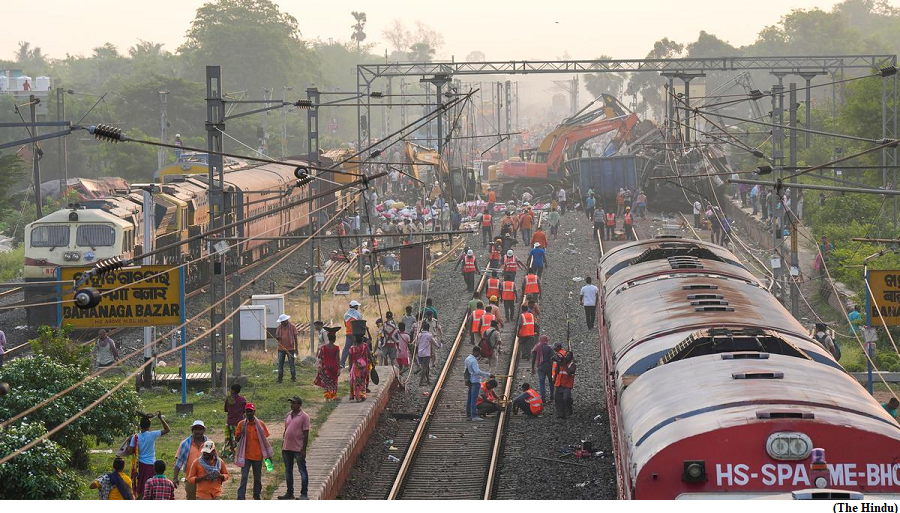Getting railway safety back on track after Odisha (GS Paper 2, Governance)

Context:
- There have been innumerable television debates following the train accident involving the 12841 Shalimar-Chennai Coromandel Express, the 12864 Sir M. Visvesvaraya Terminal Bengaluru-Howrah Superfast Express and a goods train at Bahanaga Bazar station in Balasore district, Odisha.
- But the key question that many panellists have failed to address is about how the Indian Railways can work to ensure that such catastrophes are never repeated.
Possible causes of accident:
- The interlocking of signals and routes through a series of relays and logic gates, ensures that a train is guided by signals to a route amid a maze of railway tracks in a manner that would never cause it to encounter another train, ahead or in the rear. In this case, this interlocking was overridden by manual intervention. It have two causes:
- It was most likely done by a signal maintainer who has access to the equipment hut or relay room, who may have been cutting corners to expedite his maintenance work so that the running train is not affected.
- As the Indian Railways seems to believe, it is the handiwork of ‘a saboteur’ with criminal intention to cause an accident.
Double investigation:
- The Odisha train accident is now a subject of double investigation; the first, the statutory probe by the Commissioner of Rail Safety, and the second by the Central Bureau of Investigation, which is an unprecedented move by the government. Whatever be the findings, it is not premature to examine the question that has been raised above.
Criminal aspect:
- The heart of the interlocking equipment is housed in a central relay room in the main station building and access to this room is similar to opening a bank locker; the station master and the maintainer have keys to a double lock.
- While tampering with equipment in this room is possible by the maintainer, in connivance or otherwise with the station master, the chances of a criminal acting this way are inconceivable.
- On the other hand, there are some pieces of remote equipment spread all over a railway station yard which are installed in huts and location boxes, access to which is possible only by the authorised maintainer. The possibilities of tampering are greater in such locations.
- Reportedly, in this case, it was the equipment in one such hut which was alleged to have been accessed and meddled with in this case. It is not out of place to mention that this system of protecting sensitive signalling equipment is not unique to India; something similar, if not less stringent, is prevalent even in advanced rail systems abroad.
Strengthen access to systems:
- Stronger safeguards against such misadventures, whether by the custodian himself or otherwise, may be difficult to build but it is something that must be pursued with great resolve.
- The provision of a double lock system even for remote huts in railway stations will certainly cause great inconvenience to implement, increasing the chances of train delays but is it a great price to pay given the Odisha train accident?
- This is an age of mobile phones and IT applications and it should be possible to think of a system of multiple digital authorisations to access such equipment without the physical movement of staff other than the maintainers.
- These are the things the inquiry should look into, going beyond merely identifying the culprits. Work towards devising a safer system should actually begin in earnest without waiting for any inquiry reports.
Need for upgradation:
- It was William Shakespeare who said, “Strong reasons make strong actions.” Yes, the rail network in India is largely saturated, the number of train services has gone up exponentially, and there is a need to fill all vacancies in the safety categories. All this makes it even more imperative to focus more on upgradation of track and signalling.
- The provision of Kavach, the indigenous comprehensive signalling system, could not have prevented this accident. But other aspects of safety do demand faster implementation of Kavach; this would not only enhance rail safety but also improve the sectional capacity to run more trains.
Way Forward:
- While the government having its share of the limelight following the introduction of more Vande Bharat trains and creating a hype around railway station modernisation cannot be grudged, faster execution of track and signalling work is exclusive to this.
- There is no dearth of funds as the capex investment by the central government in the Indian Railways is at an extraordinary high. Therefore, the least one can ask for is to make the Indian Railways much safer than it is today.


